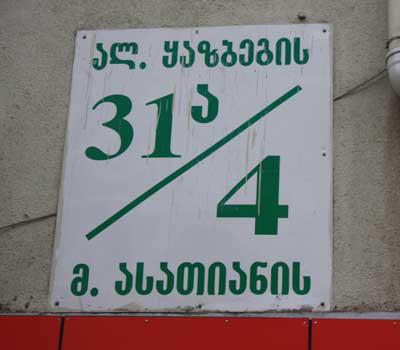Proposal:AddrN (2012)
| addr2:* | |
|---|---|
| Proposal status: | Obsoleted (inactive) |
| Proposed by: | SamuelLB |
| Tagging: | addr2:*=* |
| Applies to: | |
| Definition: | Allows an extra address to be added. Works just like addr:* |
| Statistics: |
|
| Rendered as: | Displayed next to addr:* attributes |
| Draft started: | 2012-01-19 |
Proposal
This tag is useful when something has more than one address. For example a house in a intersection might have a number signs facing each street, where both addresses are equally "official" (and both belong to the house as a whole).
Examples from Real Life
An example from Tbilisi, Georgia, which I just made to illustrate the necessity of expanding address-tags:
In the given examples, the adresses 4 Asatiani Str. and 31a Aleksandre Kazbegi Ave. are equally official and equally in use on the same building. --Moszkva ter 11:24, 20 January 2012 (UTC)
Rationale
There are some alternatives:
- Split buildings in triangles, like this: http://www.openstreetmap.org/?lat=59.219808&lon=18.185206&zoom=18&layers=M
- Place the different addresses on the nodes that make up a building.
- Create two nodes very close to each other, only with different addresses (preferably in a relation)
- Arbitrarily give different entrances the different addresses (for buildings that have more than one entrance).
These alternatives have some problems. For example, if a building is split in triangles, then "roof shape" tagging wont work. And if the addresses are placed on the nodes of the building outline it's easy to accidentally delete them. And it's also semantically incorrect, because the addresses belong to the entire building, not the individual nodes.
I think houses with more than 2 addresses are extremely uncommon.
Why keys like addr:housenumber2 aren't enough
Because the attributes in an address are related. A corner house can have two house numbers on different streets.
Examples
addr2:* is already being used by Russian mappers: Wiki page RU:Key:addr - Corner houses.
Multiple addresses are also common in residential areas in Sweden. Not so many residential areas in Sweden have been mapped with house addresses so it's hard to say exactly how common it is. My own rough guess is 5% of all corner houses in the areas where I map. Here are some examples in Trollbäcken in Sweden:
- With "triangularistion": http://www.openstreetmap.org/?lat=59.219808&lon=18.185206&zoom=18&layers=M
- With "entrance tagging" and "node tagging": http://www.openstreetmap.org/?lat=59.22034&lon=18.181022&zoom=18&layers=M
- With addr2 instead: Proposed rendering of this location http://www.openstreetmap.org/?lat=59.220074&lon=18.199089&zoom=18&layers=M
Tagging
addr2 works just like addr, but they are independent from each other (unlike for instance addr:housenumber2). Here's an example:
| Key | Value |
|---|---|
| addr:street | Red street |
| addr:street | 11 |
| addr2:street | Blue road |
| addr2:housenumber | 34 |
This POI has two addresses: 11 Red street and 34 Blue road. Both are intended to be searchable. Note that the addresses are independent of each other. A feature with the tagging above should not show up if you search for 11 Blue road for example.
Applies to
nodes, ways and areas - just like addr:*
Rendering
Typically both addresses/house numbers would be rendered next to each other. But if you're travelling along Red street then the renderer might show 11 only (or 34 if you're travelling along Blue road).
If the addresses have addr*:street specified, then the addresses/house numbers may be rendered closer to the respective street.
Features/Pages affected
None. But tools that use the addr:* keys might want to use addr2:* keys as well. Especially search (otherwise addr2 won't be very useful). It's not so important to support addr2 in mapping tools, because it's easy to add a couple of extra attributes on the POIs that have two addresses.
Caveats
- Why not using addr:2:* keys, to make sure that they are matched at the same time when looking for addr:* keys ?
- Why not also associatedStreet:2 ?
- Using suffixes *:number should allow using *:1, :2, *:3, or *:4 keys for up to 4 addresses (imagine a residence located between 4 distinct streets)... This should be extended to tag keys or to member roles.
- Keys suffixed like *:1 should be used to make distincton from unsuffixed keys; the absence of numeric suffix being used for tags that appliy to all addresses for example they could share the same street name and postal code, but two distinct house numbers in the street, but and each number having some specific tags (e.g. entrance number, or distinct levels: floor level on one street, but 2nd level on another one, or distinct corridor sides). The usual notation using only the semicolon may not be enough to correlate correctly multiple values in multiple tags — Verdy_p (talk) 21:38, 2 October 2013 (UTC)
Links
- http://help.openstreetmap.org/questions/9636/corner-houses-with-two-addresses
- Wiki page RU:Key:addr - Corner houses.
- http://taginfo.openstreetmap.org/keys/addr2:street
- http://taginfo.openstreetmap.org/keys/addr2:housenumber
Comments
Please add your comments on the discussion page.


